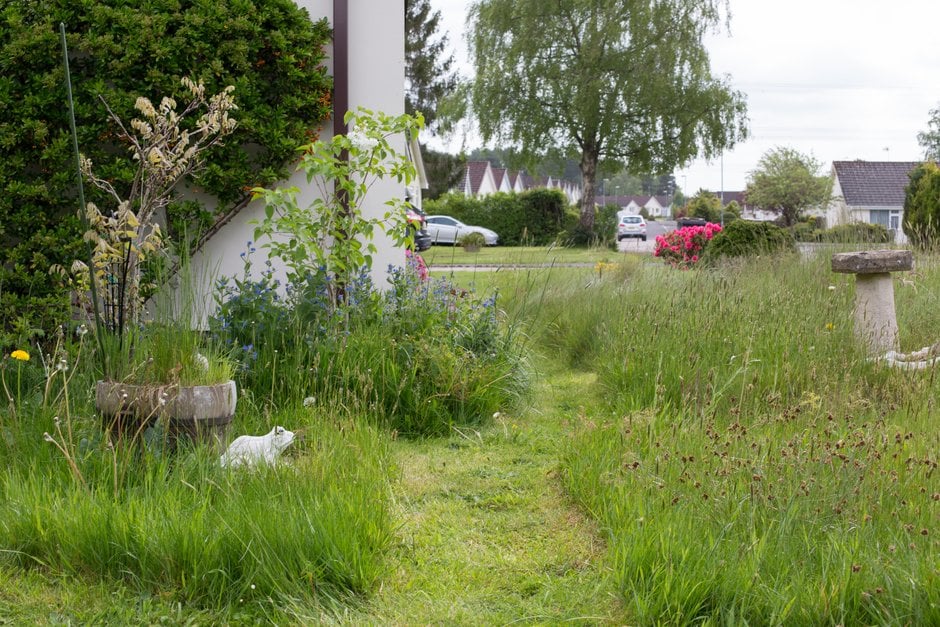Thistle: creeping
Creeping thistle is a perennial, British native that is visited by a wide range of insects. However it can quickly spread in grassland areas and borders. Once established, it can be difficult to eradicate permanently. You may find that repeated digging out of roots reduces the problem, but this may take several seasons.
Quick facts
Botanical name Cirsium arvense
Areas affected Especially grassland and uncultivated soil
Main causes Thistles spread via creeping roots and air-borne seeds
Timing Seen and treated from spring to autumn
What is creeping thistle?
Creeping thistle (Cirsium arvense) is a perennial, found throughout the British Isles and provides a food source for a range of insects and birds. Thistles can be allowed to grow in wilder areas of the garden or in flower meadows for wildlife. Learn more about making the most of lawns as a wildlife habitat and encouraging wildlife in the garden;

Lawn and mini-meadow habitats
Wildlife in gardens
Creeping thistle can become a serious weed as it spreads using
Appearance
Spreading roots mean that the thistles form large clumps of spiny leaves and flowering stems ranging from 30cm-1m (1ft-3¼ft) in height on mainly grassland.
Dark pinky-purple flowers typical of the thistle family are borne July to September.
The problem
Creeping thistle (Cirsium arvense) is such a problematic weed because;
- It produces a tap root on germination followed by lateral roots that grow horizontally. These lateral roots are brittle and produce buds at intervals that develop shoots
- It easily regenerates from broken pieces. Individual plants, can form large clumps, are dioecious (either male or female) being virtually self-sterile. However, male and female plants growing adjacent to each other will cross-pollinate and a seed crop will be produced
- Its seeds germinate readily, but particularly during periods of fluctuating temperatures, or when temperatures reach 20-30ºC (68-86ºF) during the day
Control
First, consider whether this can be done using non-chemical means such as digging out or suppressing with mulch. Where these methods are not feasible, chemical controls may need to be used.
The RHS believes that avoiding pests, diseases and weeds by good practice in cultivation methods, cultivar selection, garden hygiene and encouraging or introducing natural enemies, should be the first line of control. If chemical controls are used, they should be used only in a minimal and highly targeted manner.
Cultural control
Digging up the plants can be done at any time of year but cultural control methods are not easy but can work if consistently applied;- Digging up creeping thistles is problematic because the roots will easily regenerate from broken pieces. Persistence will be needed
- Weaken creeping thistle by repeatedly cutting down the top growth over a number of years. This is best done just before the flower heads show colour as much of the weed's food reserves will have been used up in flower production
- Clearing by digging may take two or three seasons as the plants will easily regenerate from small fragments that have been overlooked
Weedkiller control
The best time to apply weedkillers to thistles is when they are growing vigorously, but have not yet flowered.
In grass
- Apply a selective lawn weedkiller containing clopyralid (Weedol Lawn Weedkiller or Vitax LawnClear 2). Several applications may be necessary to gain control
- In rough grass areas, apply Vitax SBK Brushwood Killer, a selective herbicide based on triclopyr
In borders and unplanted areas
- Apply a systemic weedkiller containing glyphosate (e.g. Roundup Fast Action, SBM Job done General Purpose Weedkiller or Doff Advanced Weedkiller) just before the flower heads show colour
- Spray the foliage thoroughly, which should turn yellow after about a week
- Watch for any signs of regrowth the following year. You may find that two or three treatments are needed
- Glyphosate is not selective and any nearby plants or grass coming into contact with the spray may be killed
- Ensure you follow the directions on the packaging of weedkillers
Inclusion of a weedkiller product does not indicate a recommendation or endorsement by the RHS. It is a list of products currently available to the home gardener.
Download
Weedkillers for gardeners (Adobe Acrobat pdf document outlining weedkillers available to gardeners; see sections 1a, 1b and 4)
Links
Chemicals: using a sprayer
Chemicals: using safely and effectively
Chemicals: using spot and broad-scale weedkillers
Weeds: non-chemical control
See also...
Get involved
The Royal Horticultural Society is the UK’s leading gardening charity. We aim to enrich everyone’s life through plants, and make the UK a greener and more beautiful place.